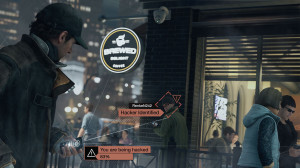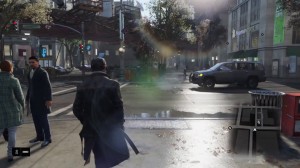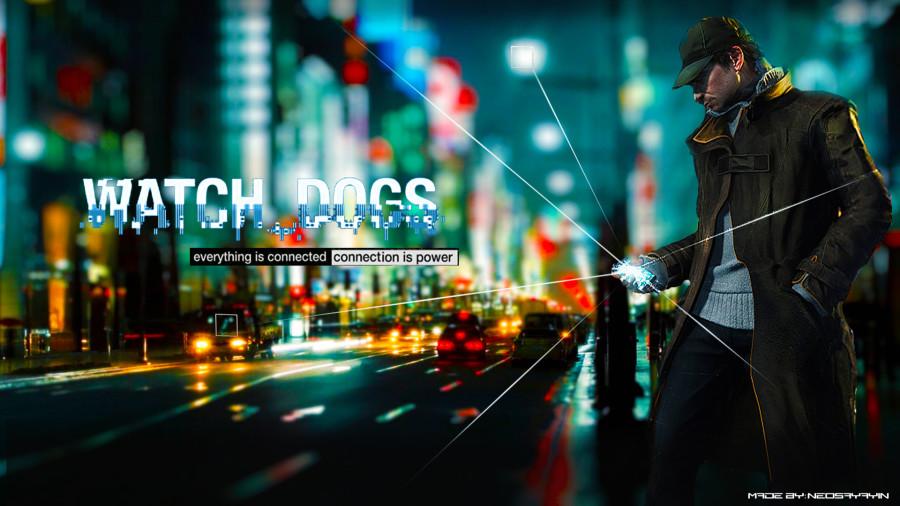
Watch Dogs is one of those games that had perhaps too much hype to deliver on, but what it does deliver is definitely an enjoyable experience. The game is far from flawless, but it is also nowhere near a bad game either. It just has some extremes in both directions, good and bad, and unfortunately these extremes can be irritating at times in comparison to the rest of the game.
Watch Dogs is yet another IP from Ubisoft that focuses on the third-person action adventure genre alongside familiar franchises such as Assassin’s Creed. In fact, if you know the looks and feel of the aforementioned franchise and even the Far Cry franchise, then you’ve got an idea of how Watch Dogs plays and looks. However, instead of being an assassin or teenager turned mercenary, you are Aiden Pearce, a hacker. Guns are not your first weapons of choice (regardless of how your playthrough actually goes), but instead you rely on weaknesses in software and its related security.
Before jumping into further detail, since this is a game revolved around hacking, it is always interesting to see how the entertainment industry interprets it. Fortunately, Watch Dogs does a decent job in interpreting hacking and how it works. While the game primarily shows Aiden’s phone doing the work, it is actually explained that it is merely accessing a server, which then does the heavy lifting. Most of the methods of gaining access are also actually through the people who work with the system instead of the magical “we can just crack the codes”. Other means of access are done in internal access locations. In short, Watch Dogs takes a few liberties here and there for the sake of keeping things moving, but it stays grounded enough to not entirely leave the realm of possibility.
Gameplay:
In short, Watch Dogs is just like every other third-person action adventure Ubisoft title made in the last five years, which isn’t necessarily a bad thing as I enjoy it, as it takes to Ubisoft’s streamlined implementation of free-roaming. If there is a wall, you can probably scale it; if you see a building, you can probably approach it. If there is water, you can probably swim in it or at least find a boat. All of this is capable with minimal input from a controller. And you have your choice of either walking or running (but who walks?). So what has Watch Dogs added to this formula besides new animations such as Aiden putting his hands in his pockets?
First of all, there is your phone which lets you profile other characters, including other players. This is a powerful tool for obtaining information, getting resources for crafting, or even obtaining money. Leveraging your phone properly is essential for completing missions, escaping chases, and general progression. However, your phone does have limitations such as requiring an existing entry point into ctOS for profiling (requiring you to unlock ctOS towers in similar fashion to other Ubisoft titles) or having a limited battery capacity. Additionally, many hacks are locked at the beginning of the game requiring you to level up and unlock new hacks via a point system.
As said, many of the hacks, crafting skills, and combat skills are locked at the start. Leveling up earns you points to then use to purchase these skills, though not all skills can be purchased right off the bat and require additional criteria to unlock. However, leveling up is fairly easy by completing missions with the maximum level being 50 as of this review. All skills can be purchased by the time you reach level 50, and can be done even before finishing the main campaign so there is little reason to be conservative or restrict your play style which takes strategy out of this feature.
Economy:
Perhaps one of the weakest features in Watch Dogs is its economy system. As mentioned earlier, your phone allows you to steal money from civilians, but what’s the point? The only things you can buy in the game are new clothes (which are purely aesthetic), new guns (most of which can be found) or ammo, vehicles (one time purchases), or pre-crafted items (extremely easy to craft). Basically, money has almost no purpose in this game once you get over $500,000 which is extremely easy to do with a few hack up grades. If there is one glaring thing Watch Dogs did wrong, it was the economy system. Money is too easy to obtain, and there is too little to spend it on.
Combat:
The recoil from the weapons feels solid, and gives each a feeling of weight. Shotguns serve their purpose of knocking enemies down, snipers snipe, and pistols go “pew pew”. However, to back up the player in combat, Watch Dogs implements a feature known as Focus. If you have ever played a F.E.A.R. game you’ll know exactly what Focus does, but if not, it’s a form of slow motion where the world slows down allowing you to react with more time. Surrounded on all sides? Enter Focus mode and headshot them all. Enemy walking too fast to land that headshot? Enter Focus mode. Of course, Focus does come with limitations for its duration and its recharge time, but it’s rarely an issue. It also slows down some of your own motions, such as peeking from behind a corner, so use it wisely. Focus can also be used while operating a vehicle.

However, Watch Dog’s strengths for combat do not come from the weapons you can use, but the variety of hacks you can use to tip the fight in your favor. Given that the entire city of Chicago has been integrated with the ctOS every piece of infrastructure is virtually under your control. This includes the cameras, stop lights, bridges, and several other entities. In combat situations you can use the cameras to plan out routes or locate targets. You can even use the cameras to get to other pieces of the city that you can then hack including exploding pipes or rising platforms. Many enemies also wear items that can be hacked such as their cellphone allowing you to distract them or even blow them up. Fights can be won without firing a single bullet, or fights can be avoided entirely in most situations. In the case a fight goes bad and you’re on the run, you can use the city infrastructure against your pursuers by causing vehicle accidents, or even blacking out the city. However, there is a limit to how much hacking you can do at any given time by the battery “charge” of your phone. For instance, manipulating traffic lights takes one bar of battery. Blowing up an enemy takes two, and so on. The capacity of your phone can be upgraded as you progress. Other than hacks and guns, you’ve got your trusty baton stick which is good for “non-lethal” (I swear the guys I hit with the baton are dead) takedowns.
AI:
So you’ve got guns, vehicles, and now your powerful cellphone, but how do your enemies react and act to make it worthwhile? Surprisingly, the AI in Watch Dogs is quite competent…most of the time. Firing a high caliber weapon at an enemy alerts practically every enemy in the area to your location to some degree. If an enemy sees a dead body they will alert others and investigate usually permanently altering their path walking. Some will even call for backup. Again, in Ubisoft fashion, enemies have an alertness bar of sorts above them indicating how suspicious they are of you. If the bar never gets fully filled you’ll be in the clear for most of your struggles. The more you alert enemies, the more aggressive they will get, and once they start firing at you, cover is essential or you will die very quickly from gunshots. The AI has pretty good aim, especially if you’re in the middle of a melee animation.
If you run in a vehicle, then so too will the AI get into vehicles for the chase, and chases only end once you are dead, or they are all dead (except for police), or they give up. I have yet to get a Level 5 chase with the police since I normally get sniped to pieces before then. However, the AI is certainly not without its quirks. Some enemies will completely ignore you until you get into a vehicle, and police magically knowing where you are heading. The ctOS scan is also a bit rigged. There is also a bit of rubber banding in vehicle chases because I didn’t know you could accelerate to 60+ MPH in reverse in less than five feet of distance, but that’s exactly what one police car did (and thus launched me off one of the freeways). Overall, the AI for hostile NPCs is competent, and they will kill you given the chance.
The AI for regular civilians is hit and miss in a literal sense. You can be driving on the road and an NPC will jump out in front of you screaming you are a maniac driver. Other times you’ll be leaving a parking lot and an NPC will jump in front of you. Most of the time though, they will jump out of the way of your vehicle. For when NPCs are driving, they follow the street laws for the most part. There were a couple of occasions where one tried to merge lanes, with me still in it. Other times I have found a few driving the wrong way on the freeways, or some making illegal turns. Again though, it’s not like some were driving off ramps… never mind on that.
Story
This is an interesting area to discuss because of spoiler issues so I’ll keep this as more of a critique rather than the drawn out explanations I like to do. Essentially, you play as Aiden Pearce, elite hacker extraordinaire. You’ve done some work in the past that has irked some of the major players in the city of Chicago, and they want you silenced. However, in an attempt to silence you they take something away from you that you cannot forgive them for, and thus you head out on your mission to make them pay. In the process of this you begin to learn about the intricacies of the crime world present in Chicago
Overall, the story is pretty good, and it contains several twists and turns that it took me until about halfway point to fully predict out the rest of the story. Even then there were a few things that while not entirely unexpected, were interesting revelations. Yet again, in Ubisoft fashion, the entire story is spread out over the various side quests that you can complete and collectibles. Most of these missions do add something more to the story, and the audio logs were interesting to listen to. The storytelling is dark when it needs to be, and humorous as needed. Each of the characters brings a different perspective to the modern world of crime. Whether it is Lucky Quinn whose era is dying out, Iraq’s Viceroys that use technology to leverage information, or the other various characters Watch Dog’s story is enjoyable.
However, the story can contrast considerably to what actions are actually being done while playing. To give credit, where the story calls for evaluation of whether or not you are truly playing as the Vigilante, it tends to be impartial. For instance, Aiden is extremely ambiguous to whether or not he acknowledges himself as a murderer. Some could call this lazy, but I think it wo
rks out just fine though it would be interesting to see the story truly reflect your play style to some degree.
Again though, I enjoyed the moral of the story, and it was executed pretty much by the book and I think that’s just fine.
Graphics:

Watch Dogs was one of those games that were showcased to be a visually impressive title for the next-gen consoles. And I would be lying if I said the game did not look good because it does. The animation of main characters is superb as expected, and the lighting and particle effects are impressivley good. Even the water looks great. However, if you focus on the things in the background you begin to see the ugly. Random NPCs don’t look the best they could, deformed vehicles can sometimes look odd, and not all animations are top-notch. There’s also the issue of frame dipping from time to time, and this especially noticeable when experience points are being added, or in high density car jams.
Play Time/Replayability:
Completing the main campaign acts can be done fairly quickly. I’ve spent close to forty hours in the game, but only about 10-12 of those hours was actually doing the campaign. The rest have been on the side quests or just running around, and I’m at about 75% completion though I have yet to touch the online components other than the occasional intrusion.
In terms of replayability, there is not much there to go back and redo. There are leaderboards for missions based on your time, but those are not that enticing to return for. About the only thing to replay Watch Dogs over for is to either be completely evil, or completely good. I went through the game as a Vigilante character for my playthrough since being chased by the police all the time didn’t sound like much fun. Your mileage will vary since the multiplayer features never interested me.
Conclusion:
Watch Dogs is a game with way too much hype behind it, but do not let deter you from trying the game. It is a fun game to play, and if you enjoy third-person action adventure games, then Watch Dogs is a game you should take a serious look at.
The Good: An impressive open world third-person action adventure game whose use of hacking is interesting to play with.
The Bad: Economy system, lack of weapon customization, a few terrible missions, and occasional performance issues.







